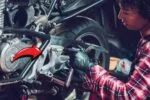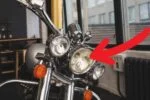10 Warning Signs Your Motorcycle Carburetor Needs Immediate Attention: A motorcycle’s carburetor plays a vital role in keeping the engine running smoothly by mixing air and fuel in the right proportion. However, like any other part of the bike, it can eventually fail due to age, wear, or damage. Recognizing the signs of carburetor failure early on can save you time, money, and headaches in the long run. Here are 10 clear indicators that your motorcycle carburetor might be malfunctioning.
Contents
- 0.1 1. Strange Sounds Coming from the Engine
- 0.2 2. Lean Air/Fuel Ratio
- 0.3 3. Black Smoke from the Exhaust
- 0.4 4. Rich Air/Fuel Ratio
- 0.5 5. Refusal to Start
- 0.6 6. Backfiring Problems
- 0.7 7. Poor Engine Performance
- 0.8 8. Idling Problems
- 0.9 9. Cold Start Difficulties
- 0.10 10. Flooded Carburetor
- 1 Conclusion
- 2 FAQ’s
1. Strange Sounds Coming from the Engine
Motorcycle engines make a variety of sounds during operation, but certain strange noises could signal a carburetor problem. If you hear popping, sneezing, or banging sounds, these could indicate that the carburetor is malfunctioning. These noises happen when the air/fuel mixture is off balance, leading to improper combustion. The popping sound often happens when the mixture is lean, and a sneezing sound can occur when there is too much air and not enough fuel.
2. Lean Air/Fuel Ratio
The air/fuel ratio is crucial for your motorcycle’s engine performance. A “lean” ratio occurs when there’s too much air and not enough fuel in the mixture, which can affect the bike’s performance. A common sign of a lean mixture is the sneezing sound mentioned earlier. If your bike runs lean, you might also notice difficulty starting the engine or a lack of power when riding. This issue could be caused by clogged carburetor jets or incorrect adjustments. If you notice this, it’s time to clean or adjust your carburetor.
3. Black Smoke from the Exhaust
If you see black smoke coming from your motorcycle’s exhaust, it’s a clear sign that your engine is burning too much fuel. This typically indicates a “rich” air/fuel ratio, where there’s more fuel than necessary. A rich ratio could be due to a carburetor malfunction, such as improperly adjusted jets or a clogged air filter. You might also notice a decrease in fuel efficiency, as the engine isn’t using fuel efficiently. To fix this, check the carburetor, air filter, and fuel jets for clogs.
4. Rich Air/Fuel Ratio
On the flip side, a carburetor that’s malfunctioning can also lead to a rich air/fuel mixture, which is characterized by an excess of fuel in the engine. This can result in black smoke coming from the exhaust and poor engine performance. If your carburetor is producing a rich mixture, it’s time to inspect it for damage and clean the carb jets. Adjusting the air/fuel ratio back to optimal levels can restore your bike’s performance.
5. Refusal to Start
A dirty or malfunctioning carburetor can make it difficult to start your motorcycle. If your bike turns over but doesn’t start, it might be due to an improper air/fuel mixture caused by a clogged carburetor. This is why regular carburetor maintenance is important to keep your bike running smoothly. Cleaning the carburetor annually should prevent this issue, and make sure to check for any clogs in the jets or float bowl.
6. Backfiring Problems
Backfiring occurs when fuel ignites outside of the combustion chamber, often as a result of an incorrect air/fuel mixture. Both lean and rich mixtures can cause backfires, and a malfunctioning carburetor is often to blame. The popping or banging sound that accompanies backfiring can be loud and disturbing. If your bike is backfiring, it’s time to clean the carburetor, check the fuel mixture, and inspect the spark plugs for any issues.
7. Poor Engine Performance
When the carburetor is failing, you’ll likely notice a decline in engine performance. Your bike may struggle to accelerate, or you might experience poor fuel efficiency. Even slight imbalances in the air/fuel ratio can cause a noticeable drop in power. If you experience these issues, it’s worth checking your carburetor for blockages or malfunctioning parts. A thorough cleaning and adjustment can improve performance.
8. Idling Problems
If your motorcycle is idling too high, it’s often a sign of a carburetor issue. The problem usually occurs when the carburetor’s air/fuel mixture is off balance, causing the engine to rev at high speeds when it should be idling smoothly. High idling could also be caused by an issue with the throttle springs, which control the throttle valve’s closure. If adjusting the air/fuel mixture doesn’t solve the issue, inspect the throttle springs for wear or damage.
9. Cold Start Difficulties
Cold start issues are common, especially on colder days when the engine is starting up. Cold air is denser, which can cause the carburetor to lean out the mixture. This means that your bike might struggle to start or run rough during the first few minutes. If your motorcycle is having trouble starting on cold mornings, you may need to adjust the carburetor to allow for a richer mixture. A carburetor jet kit can help you make these adjustments easily.
10. Flooded Carburetor
A flooded carburetor occurs when too much fuel enters the carburetor’s float bowl, leading to fuel spilling out and flooding the engine. This often happens when there is a buildup of debris in the carburetor, preventing it from properly regulating the fuel flow. If your carburetor is flooded, it can result in poor starting, wet components, and a rich air/fuel mixture. Cleaning the carburetor’s float bowl can resolve this issue.
Conclusion
The carburetor is one of the most important components of your motorcycle’s engine, and it needs to be in top condition for optimal performance. By recognizing the signs of a failing carburetor—such as strange sounds, poor engine performance, or backfiring—you can take proactive steps to fix the issue before it worsens. Regular maintenance, including cleaning the carburetor and checking the air/fuel ratio, will keep your bike running smoothly for years to come.
FAQ’s
1. How can I tell if my carburetor is malfunctioning?
Signs of a malfunctioning carburetor include strange engine sounds, difficulty starting, backfiring, black smoke from the exhaust, and poor acceleration or fuel efficiency.
2. How often should I clean my carburetor?
It’s recommended to clean your carburetor at least once a year, or more frequently if you notice signs of poor performance, such as starting issues or strange noises.
3. What causes backfiring in a motorcycle?
Backfiring can be caused by a lean or rich air/fuel mixture, which can happen if your carburetor is malfunctioning. Cleaning and adjusting the carburetor can help prevent backfiring.
4. Can a clogged air filter affect the carburetor?
Yes, a clogged air filter can restrict airflow, which can cause a rich air/fuel mixture and lead to poor engine performance. Regularly check and clean your air filter to keep the carburetor functioning properly.
5. What should I do if my carburetor is flooded?
If your carburetor is flooded, check the float bowl for debris and clean it out. This will help regulate fuel flow and prevent flooding from happening again.




